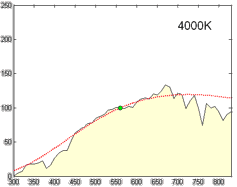Full-spectrum light
Full-spectrum light refers to light that covers the electromagnetic spectrum from infrared to near-ultraviolet, or all wavelengths that are useful to plant or animal life; in particular, sunlight is considered full spectrum, even though the solar spectrum does not cover all wavelengths. The term is often used in relation to light bulbs that are designed to mimic this natural light. Full-spectrum lighting is used in a variety of applications, from horticulture to the design of environments for individuals with specific health conditions, such as Seasonal Affective Disorder (SAD).
Overview[edit | edit source]
Full-spectrum light sources are necessary for many biological functions. Humans benefit from sunlight exposure, which influences vitamin D metabolism and has implications for mood, sleep, and general health. Similarly, plants rely on full-spectrum light for photosynthesis, the process by which they convert light energy into chemical energy. Consequently, artificial full-spectrum lighting is important in indoor gardening and agriculture, especially in regions with insufficient natural sunlight.
Characteristics[edit | edit source]
The key characteristics of full-spectrum light include a balanced distribution of light across the entire spectrum of visible light, from 400 to 700 nanometers, and a Color Rendering Index (CRI) close to 100, indicating that objects under this light appear similar to how they would under natural sunlight. Additionally, full-spectrum lighting often includes ultraviolet (UV) and infrared (IR) wavelengths outside the visible spectrum, which are believed to have health benefits.
Applications[edit | edit source]
Horticulture[edit | edit source]
In horticulture, full-spectrum LED lights are increasingly popular for indoor and hydroponic gardening. These lights support the growth of plants by providing a balanced spectrum that mimics natural sunlight, promoting photosynthesis and healthy plant development.
Health and Wellness[edit | edit source]
Full-spectrum lighting is also used to treat Seasonal Affective Disorder (SAD), a type of depression that occurs at a certain time of the year, usually in the winter. Light therapy, which involves exposure to bright, full-spectrum light, is a common treatment. Additionally, full-spectrum light is used in environments where natural light exposure is limited, such as in offices and schools, to improve mood and productivity.
Photography and Art[edit | edit source]
In photography and art studios, full-spectrum lights are preferred for their ability to accurately render colors. This is crucial for artists working on projects that require precise color matching and for photographers who need a light source that closely resembles natural sunlight.
Controversy[edit | edit source]
While full-spectrum lighting is marketed as beneficial for health and well-being, some experts argue that the term "full-spectrum" is not well-defined and that the benefits of such lighting over standard lighting options are not conclusively proven. Critics suggest that more research is needed to fully understand the effects of full-spectrum light on human health and plant growth.
Conclusion[edit | edit source]
Full-spectrum light plays a crucial role in various fields, from agriculture to health care. Despite the ongoing debate regarding its benefits, the demand for lighting solutions that mimic natural sunlight continues to grow, driven by the desire to replicate the sun's positive effects on plants and humans.
Search WikiMD
Ad.Tired of being Overweight? Try W8MD's physician weight loss program.
Semaglutide (Ozempic / Wegovy and Tirzepatide (Mounjaro / Zepbound) available.
Advertise on WikiMD
|
WikiMD's Wellness Encyclopedia |
| Let Food Be Thy Medicine Medicine Thy Food - Hippocrates |
Translate this page: - East Asian
中文,
日本,
한국어,
South Asian
हिन्दी,
தமிழ்,
తెలుగు,
Urdu,
ಕನ್ನಡ,
Southeast Asian
Indonesian,
Vietnamese,
Thai,
မြန်မာဘာသာ,
বাংলা
European
español,
Deutsch,
français,
Greek,
português do Brasil,
polski,
română,
русский,
Nederlands,
norsk,
svenska,
suomi,
Italian
Middle Eastern & African
عربى,
Turkish,
Persian,
Hebrew,
Afrikaans,
isiZulu,
Kiswahili,
Other
Bulgarian,
Hungarian,
Czech,
Swedish,
മലയാളം,
मराठी,
ਪੰਜਾਬੀ,
ગુજરાતી,
Portuguese,
Ukrainian
Medical Disclaimer: WikiMD is not a substitute for professional medical advice. The information on WikiMD is provided as an information resource only, may be incorrect, outdated or misleading, and is not to be used or relied on for any diagnostic or treatment purposes. Please consult your health care provider before making any healthcare decisions or for guidance about a specific medical condition. WikiMD expressly disclaims responsibility, and shall have no liability, for any damages, loss, injury, or liability whatsoever suffered as a result of your reliance on the information contained in this site. By visiting this site you agree to the foregoing terms and conditions, which may from time to time be changed or supplemented by WikiMD. If you do not agree to the foregoing terms and conditions, you should not enter or use this site. See full disclaimer.
Credits:Most images are courtesy of Wikimedia commons, and templates, categories Wikipedia, licensed under CC BY SA or similar.
Contributors: Prab R. Tumpati, MD


